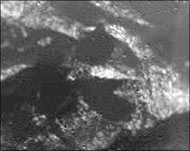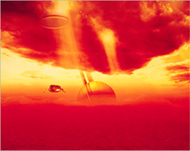Titan probe beams breathtaking photos
The world has got its first look at the surface of the Saturnian moon Titan with European space probe Huygens beginning to send breathtaking pictures.

The first picture taken from a height of about 16km, as Huygens descended before landing on the Titan surface on Friday, showed a possibly rocky surface with “drainage channels” for liquids.
Scientists speculated the channels might feed into canyons on the surface.
“I think none of us would have expected this kind of unveiling, but it is pretty consistent with the surprises we have seen before,” said Al Diaz, Nasa’s associate administrator for science.
Joint endeavour
The $3 billion Cassini-Huygens mission, a joint project of Nasa and the European and Italian space agencies, was launched in 1997 from Cape Canaveral, Florida, to study Saturn, its rings, moons and magnetosphere.
In December, the Saturn explorer Cassini dropped off Huygens for a three-week journey toward Titan, culminating in the probe’s parachute-slowed plunge to the moon’s surface.
 |
|
One of the first pictures showed |
The photos were beamed from the European Space Agency’s headquarters in Germany.
Officials there said it appeared that Huygens landed on some sort of solid surface rather than in liquid. They did not offer any speculation on where the “drainage channels” in the photo might lead or how they were formed.
Titan is believed to have liquid methane and ethane on its surface, but the moon’s heavy fog blanket made it unclear what Huygens would encounter when it reached its landing site.
Huge success
“We can say this afternoon we have a scientific success,” said Jean-Jacques Dordain, director-general of the European Space Agency.
Cassini, which acted as the relay station for Huygens, sent back signals showing it had finished retrieving and had turned towards Earth to begin transmission of a likely three hours of data.
The 705lb probe made its two-hour descent through Titan’s atmosphere to the surface after a seven-year journey piggybacked on Cassini and a final one-way trip of about three weeks on its own.
 |
|
A recent artist’s impression of |
Scientists expect to spend years poring over the results.
“It’s got to be unravelled, got to be put together and then scientists being scientists are going to argue about what it means as we piece together our place in the universe and how we came to be,” said David Southwood, ESA’s director of scientific programme.
Special design
The saucer-shaped probe was designed to rotate on its way down, taking high-definition, panoramic images of Titan’s thick, smoggy atmosphere and its landscape.
Along with its six scientific instruments that measure the components of Titan’s atmosphere, Huygens carries a sound recorder and a lamp to look for signs of surface liquid.
Titan, believed to be the only moon in the solar system with an atmosphere, is larger than Mercury and Pluto.
Some science team members monitoring the flight have waited decades to see the first of 750 planned images and other scientific readings from the yellow-skied moon.
Huygens was named after the Dutch scientist who discovered Titan in 1655.